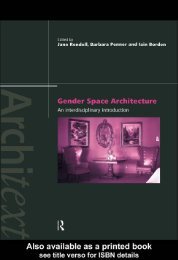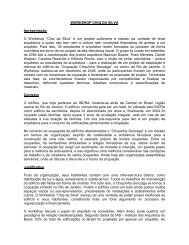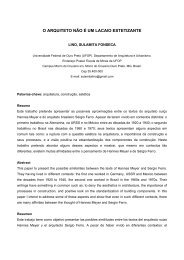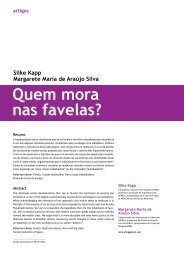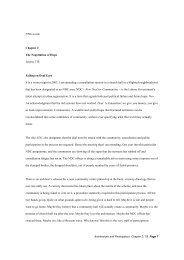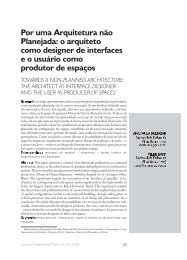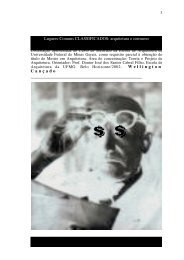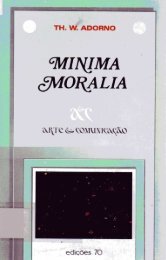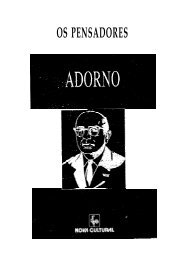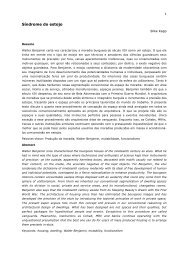The production of everyday life public space - MOM. Morar de ...
The production of everyday life public space - MOM. Morar de ...
The production of everyday life public space - MOM. Morar de ...
Create successful ePaper yourself
Turn your PDF publications into a flip-book with our unique Google optimized e-Paper software.
How to quote this text: Milagres, L. Kapp, S. and Baltazar, A. P., 2010. <strong>The</strong> <strong>production</strong> <strong>of</strong> <strong>everyday</strong> <strong>life</strong> <strong>public</strong> <strong>space</strong>.<br />
Translated from Portuguese by Daniel Paschoalin, V!RUS, 04, [online] Available at:<br />
[Accessed day month year].<br />
<strong>The</strong> <strong>production</strong> <strong>of</strong> <strong>everyday</strong> <strong>life</strong> <strong>public</strong> <strong>space</strong><br />
Lígia Milagres, Silke Kapp, Ana Paula Baltazar<br />
Ligia Milagres is an Architect and Researcher <strong>of</strong> the group Living in<br />
Other Ways (<strong>MOM</strong>-UFMG), Brazil.<br />
Silke Kapp is an Architect, Doctor and Master in Philosophy,<br />
Associate Pr<strong>of</strong>essor at School <strong>of</strong> Architecture, Universida<strong>de</strong> Fe<strong>de</strong>ral<br />
<strong>de</strong> Minas Gerais and Coordinator <strong>of</strong> the group Living in Other Ways<br />
(<strong>MOM</strong>-UFMG), Brazil.<br />
Ana Paula Baltazar is an Architect, Ph.D. in Architecture and Virtual<br />
Environments and Master in Architecture, Associate Pr<strong>of</strong>essor at<br />
School <strong>of</strong> Architecture, Universida<strong>de</strong> Fe<strong>de</strong>ral <strong>de</strong> Minas Gerais and<br />
Researcher <strong>of</strong> the group Living in Other Ways (<strong>MOM</strong>-UFMG), Brazil.<br />
Abstract<br />
<strong>The</strong> paper is an excert <strong>of</strong> the author's Masters thesis about the <strong>production</strong> <strong>of</strong> <strong>everyday</strong> <strong>public</strong><br />
<strong>space</strong>s. Instead <strong>of</strong> addressing the <strong>public</strong> <strong>space</strong>s in general, in its historical or institutional<br />
sense, it seeks to investigate the <strong>space</strong>s left when private and closed lands are subtracted.<br />
<strong>The</strong>y are si<strong>de</strong>walks, streets, central walkways in main roads, small neighborhood parks,<br />
residual <strong>space</strong>s and other open <strong>space</strong>s that can be occupied or even physically transformed by<br />
the neighborhood dwellers. However, as urban planning usually prioritizes the circulation <strong>of</strong><br />
cars, commodities and people, this possibility is limited and rarely explored.
To inform the discussion on people’s engagement with the <strong>production</strong> <strong>of</strong> such <strong>space</strong>s, this<br />
paper <strong>de</strong>scribes a specific case in Belo Horizonte — one <strong>of</strong> the largest Brazilian cities. It is the<br />
case <strong>of</strong> an interrupted stretch <strong>of</strong> street that is abandoned, located in an upper middle class<br />
neighbourhood. In or<strong>de</strong>r to test the <strong>de</strong>gree <strong>of</strong> engagement or passiveness <strong>of</strong> the neighbours, a<br />
tactic <strong>of</strong> distributing leaflets directing people to a blog created to discuss what to do with this<br />
<strong>public</strong> <strong>space</strong> was adopted. This paper <strong>de</strong>scribes the evi<strong>de</strong>nces raised by the discussions in the<br />
blog concerning people’s <strong>everyday</strong> passivity and the habitual <strong>de</strong>legation <strong>of</strong> <strong>de</strong>cisions about<br />
<strong>public</strong> <strong>space</strong>s to third parties. Our findings inform a discussion on an alternative urbanism that<br />
relies on tools with which people might engage in the <strong>production</strong> <strong>of</strong> <strong>public</strong> <strong>space</strong>s.<br />
Keywords: <strong>public</strong> <strong>space</strong>s, collective <strong>production</strong>, engagement<br />
1. Specialized <strong>public</strong> <strong>space</strong> and <strong>everyday</strong> <strong>public</strong> <strong>space</strong><br />
When it comes to the issue <strong>of</strong> the journal, <strong>de</strong>signing coexistence, it is necessary to go beyond<br />
the discussion that consi<strong>de</strong>rs only the appropriation <strong>of</strong> <strong>public</strong> <strong>space</strong>s, moving towards a <strong>de</strong>bate<br />
about their collective <strong>production</strong>. Namely, a critical reflection on the <strong>public</strong> <strong>space</strong>s should not<br />
be restricted to those <strong>de</strong>signed by specialists, but directed to areas subject to collective<br />
<strong>production</strong> in the micro-local scale, that is, the dwelling scale and its immediate urban<br />
surroundings. To this end, we investigate an urban situation that have conditions for collective<br />
<strong>de</strong>sign in <strong>everyday</strong> <strong>life</strong>. Such coexistence is un<strong>de</strong>rstood here as the political practice <strong>of</strong><br />
discussion and transformation <strong>of</strong> <strong>space</strong>s.<br />
Instead <strong>of</strong> a generically approaching <strong>public</strong> <strong>space</strong>s, using the formal and the institutional sense<br />
<strong>of</strong> the large <strong>public</strong> facility, matter investigating the use <strong>of</strong> all that is left when the private lot<br />
and the gated community are subtracted <strong>of</strong> the <strong>everyday</strong> <strong>space</strong>: the si<strong>de</strong>walks, streets,<br />
gar<strong>de</strong>ns on median strips <strong>of</strong> avenues, small neighborhood parks, the remnants <strong>of</strong> past projects<br />
and other free <strong>space</strong>s. <strong>The</strong>y can be employed in many ways, more or less spontaneous, more<br />
or less organized, for meetings, parties, sports, business or leisure; sporadic or routinely; in<br />
projects <strong>of</strong> few hours or months, consi<strong>de</strong>ring uses that dispense physical transformation or<br />
that, on the contrary, require it.<br />
However, these possibilities <strong>of</strong> occupation and transformation have been un<strong>de</strong>r-exploited in the<br />
context <strong>of</strong> an urban planning that prioritizes circulation <strong>of</strong> cars, goods and people, and in the<br />
context <strong>of</strong> a land subdivision <strong>of</strong>ten done without concerning the quality <strong>of</strong> <strong>public</strong> <strong>space</strong> linking<br />
the plots. <strong>The</strong> results have been squares and equipment <strong>de</strong>signed by specialists but not<br />
suitable and not cared by resi<strong>de</strong>nts, and the disregard for the <strong>public</strong> areas surrounding the<br />
dwelling.<br />
This occupational pattern, which repeats itself also at the self-produced areas <strong>of</strong> the city, fits<br />
perfectly with a well centralized management. Together, the logic <strong>of</strong> the private lot and the
logic <strong>of</strong> centralized management interdict the engagement <strong>of</strong> people in the <strong>public</strong> <strong>everyday</strong><br />
<strong>space</strong>. <strong>The</strong>re are many districts and neighborhoods where resi<strong>de</strong>nts ignore or neglect<br />
completely the possibility <strong>of</strong> intervening, consi<strong>de</strong>ring that caring for everything that is not<br />
private property should be governance’s duty. But, and <strong>de</strong>spite all the prohibitions, there are<br />
also places where resi<strong>de</strong>nts take the initiative and engage in improvements.<br />
This variation in the level <strong>of</strong> engagement <strong>of</strong> the population should be consi<strong>de</strong>red in the <strong>de</strong>bate<br />
on the <strong>production</strong> <strong>of</strong> <strong>public</strong> <strong>space</strong>s. Surely the commitment cannot be taken as an assumption,<br />
but neither the non-engagement. What is involved here is not only the use, much less a<br />
popular adherence or use to a plan or <strong>de</strong>sign, but the practice <strong>of</strong> the right to the city as David<br />
Harvey (2008) proposes, in addition to individual freedom <strong>of</strong> access to urban resources, or in<br />
other words, the <strong>de</strong>cision-making exercise and the direct action on the urban <strong>space</strong> <strong>of</strong><br />
<strong>everyday</strong> coexistence.<br />
<strong>The</strong> behavior <strong>of</strong> people in relation to non-specialized areas, namely, not <strong>de</strong>signed by experts<br />
and having no pre<strong>de</strong>fined program uses, are concrete samples <strong>of</strong> the <strong>de</strong>gree <strong>of</strong> engagement<br />
with the urban area surrounding the dwelling. This engagement is the ability to organize,<br />
discuss and transform autonomously and collectively the <strong>space</strong>s, being conditioned by each<br />
context characteristics, ranging from the minimum <strong>de</strong>gree [<strong>space</strong>s are ignored] to the<br />
maximum [the surrounding community appropriates <strong>space</strong>, not only caring but proposing and<br />
implementing interventions]. To inform this discussion were observed <strong>space</strong>s located in<br />
resi<strong>de</strong>ntial areas <strong>of</strong> Belo Horizonte. <strong>The</strong> city has features <strong>of</strong> most major Brazilian cities: their<br />
<strong>public</strong> <strong>space</strong>s emphasize the transport lanes at the expense <strong>of</strong> si<strong>de</strong>walks, generating <strong>public</strong><br />
areas that are nothing more than barren wastelands. Since the goal is to un<strong>de</strong>rstand what is<br />
behind a picture in which the disengagement seems to be the rule, we initially investigate one<br />
example <strong>of</strong> the more common case: that in which the <strong>de</strong>gree <strong>of</strong> commitment is very low.
2. [Almost] zero engagement<br />
Figura 1: Aerial view <strong>of</strong> the un<strong>de</strong>veloped portion <strong>of</strong> Nicaragua Street [area colored in red]. Source: Google Earth<br />
We find a typical example <strong>of</strong> the lower <strong>de</strong>gree <strong>of</strong> engagement in a neighborhood <strong>of</strong> uppermiddle<br />
class in southern region <strong>of</strong> Belo Horizonte. This is an un<strong>de</strong>veloped stretch <strong>of</strong> the street<br />
Nicaragua, due to an error in the geometric <strong>de</strong>sign <strong>of</strong> the street which led to a gap in relation<br />
to the level <strong>of</strong> adjacent roads that impe<strong>de</strong>s the connection with the overall frame. <strong>The</strong> area is<br />
surroun<strong>de</strong>d by buildings, or rather the stilts that support and level them in relation to nearby<br />
streets. Thus, none <strong>of</strong> the buildings have direct access to the area in question, which<br />
contributes significantly to its abandonment by its resi<strong>de</strong>nts. <strong>The</strong> city’s superinten<strong>de</strong>nt <strong>of</strong> urban<br />
cleaning, monthly weeding the place, is the only carrying the <strong>space</strong>. And it not used except by<br />
some passer-by who use it as a shortcut, and according to the testimony <strong>of</strong> neighbors, by<br />
young-ones doing supposing illegal practices. This relative lack <strong>of</strong> activity creates an<br />
intimidating and vulnerable environment, whose ways <strong>of</strong> living and vitality are not envisioned<br />
by the resi<strong>de</strong>nts. Thus, an area that could settle a positive <strong>public</strong> <strong>space</strong>, conducting the<br />
construction <strong>of</strong> the buildings as a cluster 1 , is only a negative <strong>space</strong>, residual <strong>of</strong> the selfabsorbed<br />
implantation <strong>of</strong> neighboring buildings.<br />
1 Christopher Alexan<strong>de</strong>r argues the provision in cluster [cluster or group] against the conventional layout <strong>of</strong> dwellings<br />
in the grid [mesh Hippodamic]. See “<strong>The</strong> <strong>production</strong> <strong>of</strong> houses” (1985), especially the chapter "<strong>The</strong> collective <strong>de</strong>sign <strong>of</strong><br />
common land".
Figura 2: Meeting <strong>of</strong> one si<strong>de</strong> <strong>of</strong> Nicaragua Street with the un<strong>de</strong>veloped stretch. Source: Author's Personal Archive<br />
As Nicaragua street is part a <strong>of</strong> upper-middle class neighborhood, the structural reasons for<br />
the apparent disinterest it may seem obvious: who has the ease and pleasures in private <strong>space</strong><br />
does not care about the quality <strong>of</strong> <strong>public</strong> <strong>space</strong>. However, this still does not explain how the<br />
situation is handle by resi<strong>de</strong>nts on a day-to-day, that is, as they perceive it personally. To<br />
confirm or <strong>de</strong>ny the lack <strong>of</strong> interest and to un<strong>de</strong>rstand the lack <strong>of</strong> initiatives <strong>of</strong> use or<br />
appropriation, we resorted to an attempt to mobilization by distributing a flyer in the<br />
neighborhood 2 (Figura 3 and 4).<br />
2 <strong>The</strong> <strong>MOM</strong> group is using flyers as a tactic to mobilize to discussing the <strong>production</strong> <strong>of</strong> <strong>space</strong>, inspired in pamphlets<br />
distributed by the Suffragettes at the beginning <strong>of</strong> the century, in addition to conveying i<strong>de</strong>as, had an explicit policy<br />
goal. <strong>The</strong> pamphlets, flyers to discuss the <strong>production</strong> <strong>of</strong> <strong>space</strong>. Available at: .
Figura 3: Flyer. Source: Author's Personal Archive<br />
Figura 4: Camouflage pamphlet. Source: Author's Personal Archive
<strong>The</strong> flyer inclu<strong>de</strong>d a call for participation in a web-blog created for this purpose because,<br />
<strong>de</strong>spite the lack <strong>of</strong> neighbors meet to discuss common problems, they fit the pr<strong>of</strong>ile <strong>of</strong> Internet<br />
and social networks users. With questions like "Do you use the green piece <strong>of</strong> street<br />
Nicaragua" and images that refer to the real abandon and some potential uses, the flyer<br />
should give visibility to the site and urge the resi<strong>de</strong>nts to discuss the matter. To do so, care<br />
was taken in preparing the content, so the images do not induce this or that proposal.<br />
Forty Thousand flyers were distributed in the buildings near the street Nicaragua. Contrary to<br />
the most common distribution practice <strong>of</strong> pamphleteering on the street without ceremony, it<br />
was necessary to mask the flyers in envelopes, so that the gatekeepers <strong>of</strong> the buildings would<br />
not question its merits and send them to the apartments. Even in the few buildings with no<br />
doorman, the flyers were enveloped and addressed to each apartment, to increase the chance<br />
for resi<strong>de</strong>nts to give them some attention. Another thousand flyers were posted, without<br />
envelopes, in mailboxes <strong>of</strong> resi<strong>de</strong>nces and in the counters <strong>of</strong> the snack bar and bakery in the<br />
region.<br />
Figura 5 - Blog for discussion <strong>of</strong> the Nicaragua Street. Source: Nicaragua Street Blog. Available at:<br />
.<br />
<strong>The</strong> web-blog received fourteen postings during the eleven days <strong>of</strong> leafleting. A collaborator<br />
called "resi<strong>de</strong>nt" had been created, with open email and password, so that anyone could post<br />
contributions without the need <strong>of</strong> i<strong>de</strong>ntification. Thus, the most manifested anonymously.<br />
Among the group <strong>of</strong> anonymous, the prevailing tone was <strong>of</strong> fear, complaints about taxes and<br />
claims for the government, <strong>de</strong>monstrating that participants see the street Nicaragua as a<br />
problem to be solved by an external body. Also frequent was the reference, sometimes<br />
extremely biased, to the resi<strong>de</strong>nts <strong>of</strong> a nearby slum and the need for policing to keep them<br />
away.
[...] We have a vacant lot taken by garbage and drug addicts. I wish<br />
the end <strong>of</strong> the street was transformed into a <strong>public</strong> square with a police<br />
station, because it was opened a shortcut that goes to the [slum] Morro<br />
do Papagaio. (Nicaragua Street Blog, 7/28/2010)<br />
[..] It's a shame that the city prefecture, aware <strong>of</strong> the problem, takes no<br />
action [...] we pay a high property tax and we do not have the services<br />
that are states’ obligation. I am in favor <strong>of</strong> a square with a police<br />
guardhouse on the site. We pay a lot to live in this area then we can<br />
take what is owed. (Nicaragua Street Blog, 7/29/2010)<br />
[..] This for me is a shame, SHAME. I hope they do something about it,<br />
since we pay and expect results. <strong>The</strong> U.S. charge 6% tax and do<br />
everything to society, here we pay more than 60% and they cannot<br />
stretch an arm. (Nicaragua Street Blog, 7/28/2010)<br />
[..] Is not easy to live next to that nest <strong>of</strong> criminals. I think there should<br />
be a park with a <strong>de</strong>cent crossing [...]. Of course, with a PERMANENT<br />
military police guardhouse, after all, from this slum next to it... we can’t<br />
expect much good. I hope our "prayers" to be heard because we pay the<br />
taxes! Hugs and congratulations for the blog initiative! (Nicaragua Street<br />
Blog, 7/25/2010)<br />
Some participants <strong>of</strong> the blog seemed to assume the existence <strong>of</strong> a previously <strong>de</strong>fined action,<br />
controlled by an institution or company, like in market research or advertising campaigns that<br />
advertise the product only after a preparatory phase <strong>of</strong> suspense. In these cases, participants<br />
felt that they should stand for or against, without even knowing the content <strong>of</strong> the supposed<br />
"work".<br />
[...] We would fully support the work that will happen on the street<br />
Nicaragua [...] We are please. (Nicaragua Street Blog, 7/25/2010)<br />
Facing these postings, too focused on claims or passive supporting, we ma<strong>de</strong> interference on<br />
the blog suggesting the possibility <strong>of</strong> intervention by the resi<strong>de</strong>nts:<br />
Can’t we think on actions that are within our reach to begin the street<br />
improvement I went there the other day and saw that someone planted<br />
seedlings near the buildings’ structure ... (Nicaragua Street Blog,<br />
7/27/2010)<br />
After that comment, the perspective has changed slightly. Some resi<strong>de</strong>nts showed more<br />
proactive and, curiously, came to be i<strong>de</strong>ntified.<br />
Well, the typical Brazilian posture <strong>of</strong> waiting for the government<br />
initiative <strong>of</strong>ten results in disappointment. Thus, given our context, the<br />
pro-community activity could be more fruitful. (Nicaragua Street Blog,<br />
7/28/2010)<br />
Well, one <strong>of</strong> the main mechanisms for <strong>de</strong>-marginalizing a place is its<br />
use. I imagine that if there were trees, si<strong>de</strong>walks, toys, squares,<br />
gymnastic equipments, bars for stretching etc... as the JK square, and<br />
with local people frequenting the local more <strong>of</strong>ten, a guardhouse would<br />
not be necessary. (Nicaragua Street Blog, 7/25/2010)<br />
I also believe that if the <strong>space</strong> is used by the neighborhood, it would no<br />
longer be bleak and dangerous, without needing guardhouse. Moreover,<br />
there are plenty <strong>of</strong> windows facing the street Nicaragua, it is already a<br />
<strong>space</strong> easy to watch over. (Nicaragua Street Blog, 7/29/2010)<br />
It would be won<strong>de</strong>rful to have a green <strong>space</strong> that surely would only add<br />
(value) to our neighborhood. I agree joining this movement. Lets
mobilize and see if the mayor is really concerned and turned into<br />
making our city more enjoyable. (Nicaragua Street Blog, 7/29/2010)<br />
This last comment indicates, however, that even among participants with a willingness to act,<br />
the perspective <strong>of</strong> intervene directly in the <strong>space</strong> is not predominant, but the i<strong>de</strong>a <strong>of</strong><br />
pressuring on external bodies supposedly responsible for it.<br />
If we could draw a sketch <strong>of</strong> the re-urbanization <strong>of</strong> the place or<br />
something, we could <strong>de</strong>velop a project to plead resources for <strong>de</strong>veloping<br />
a executive project for the implementation. How I think it's quite<br />
feasible to get resources from environmental/social compensation <strong>of</strong><br />
mining ventures, for example. However, it is necessary first <strong>of</strong> all,<br />
creating a legal entity that represents the community and to give<br />
legitimacy and credibility to any attempts <strong>of</strong> prospecting resources.<br />
I believe the path is to seek the help <strong>of</strong> some politician who represents<br />
the neighborhood, or <strong>public</strong> entities who take care <strong>of</strong> parks in the<br />
metropolitan area to <strong>de</strong>velop a "green" project to the site. But carefully,<br />
not transforming it in a car road or in a place <strong>of</strong> mess on the weekends.<br />
(Nicaragua Street Blog, 7/28/2010)<br />
<strong>The</strong> blog was used by resi<strong>de</strong>nts as a mean to <strong>de</strong>liver positions in a comfortable way, what is<br />
clear by the fact that the vast majority <strong>of</strong> comments are anonymous. During the discussion<br />
days in the blog, there has been no concrete action in <strong>space</strong> or even increased the number <strong>of</strong><br />
passers-by. That is, the blog was not used as a means to structure activities in <strong>space</strong>, but<br />
opened a channel for discussion and exchange <strong>of</strong> information that did not existed before. We<br />
observed that the resi<strong>de</strong>nts are not entirely indifferent to the subject, though their<br />
concernment is also not sufficiently strong to overcome the habit <strong>of</strong> <strong>de</strong>legating <strong>de</strong>cisions about<br />
<strong>public</strong> <strong>space</strong> to third parties.<br />
<strong>The</strong> case <strong>of</strong> street Nicaragua is no exception, but rather indicates with relative clarity how the<br />
logics mentioned in the beginning (private estate and centralized management <strong>of</strong> <strong>public</strong> <strong>space</strong>)<br />
are embed<strong>de</strong>d by individuals. It is assumed the functionalization <strong>of</strong> the <strong>public</strong> area and the<br />
consequent subdivision into specialized areas, whether for leisure, either to the monotonous<br />
movement <strong>of</strong> pe<strong>de</strong>strians and rushed cars. Thus, contact <strong>of</strong> the resi<strong>de</strong>nts with their street also<br />
tends to be purely functional. As Le Corbusier wanted, the street is only used to circulate.<br />
What's on the other si<strong>de</strong> <strong>of</strong> the fence does not seem interesting enough to arouse actions or<br />
even discussions on its use. It is a practice giving support, verbally, to the <strong>de</strong>ployment <strong>of</strong> a<br />
improvement work ma<strong>de</strong> by the city management, but the interest hardly extends beyond the<br />
fact that it values the particular property.<br />
In neighborhoods, on the scale <strong>of</strong> <strong>everyday</strong> <strong>life</strong>, such functionalization could be subverted by<br />
resi<strong>de</strong>nts, beginning with the appropriation <strong>of</strong> areas that, for lapses in planning or<br />
management, have not yet been tagged. Unlike the <strong>production</strong> brokered by an outsi<strong>de</strong> group,<br />
which <strong>of</strong>ten leads to empty <strong>space</strong>s, the collective <strong>production</strong> with some local autonomy is more<br />
direct and agile and can provi<strong>de</strong> environments organically linked to the resi<strong>de</strong>nts. Places like<br />
the green stretch <strong>of</strong> street Nicaragua have dimensions and a kind <strong>of</strong> integration that would<br />
facilitate interventions by the <strong>public</strong> to which it belongs, the inhabitants <strong>of</strong> the neighborhood.
In fact, the Nicaragua street would need few increments to be frequented on the day-by-day,<br />
dispensing complex projects and even the backing <strong>of</strong> municipal bodies, because there is no<br />
geotechnical problems, and lighting and drainage are installed.<br />
Figura 6: Trash scattered on the green area: Source: Author's Personal Archive<br />
Figura 7: almost flat area with few trees planted: Source: Author's Personal Archive
Figura 8: Lighting stilts and one <strong>of</strong> the buildings that give back to the site. Source: Author's Personal Archive<br />
As already mentioned, we did an insertion on the web-blog to remember that there are actions<br />
within the reach <strong>of</strong> resi<strong>de</strong>nts who do not require much money or the help <strong>of</strong> an external body.<br />
However, prevailed the un<strong>de</strong>rstanding that they should appeal to a specialist, make a reurbanization<br />
project and, with the help <strong>of</strong> some politician, plead the implementation by<br />
government. We consulted then, the South Central Regional, the body <strong>of</strong> the municipality <strong>of</strong><br />
Belo Horizonte that is responsible for the neighborhood 3 . Its technicians consi<strong>de</strong>r that the place<br />
needs a large and lingering intervention. <strong>The</strong>y recommend that resi<strong>de</strong>nts make an agreement<br />
with the city hall or align with any politician to get the “great work” prioritized in the municipal<br />
budget. In other words, the obstacles to an action <strong>of</strong> resi<strong>de</strong>nts in a <strong>public</strong> <strong>space</strong> that concerns<br />
them directly and daily are doubles. <strong>The</strong> government takes the heroic position to meet all the<br />
<strong>de</strong>mands on any scales – which obviously never actually happens – and citizens, at best,<br />
engage in claim this assistance.<br />
<strong>The</strong> assumption that <strong>public</strong> <strong>space</strong> is the responsibility <strong>of</strong> an external body makes that the<br />
security <strong>of</strong> the site also to be addressed mainly by the way <strong>of</strong> heteronomy. One <strong>of</strong> the<br />
contributions mentioned above has looked at the possibility <strong>of</strong> spontaneous surveillance in the<br />
neighborhood, since there are many windows facing the street Nicaragua. But most <strong>of</strong> the<br />
participant adhered to the proposed installation <strong>of</strong> a military police guardhouse, to ensure the<br />
segregation <strong>of</strong> the nearby slum, which was seen as a threat. In this sense, the most<br />
wi<strong>de</strong>spread opinion seems to coinci<strong>de</strong> with the "Defensible Space <strong>The</strong>ory" formulated by Oscar<br />
3 Information <strong>of</strong> a technical for Regional Center-South, obtained in a telephone interview conducted by Ligia Milagres.
Newman in the 1970s, an urban <strong>de</strong>sign that folds police state, without "ambushes", so that the<br />
consi<strong>de</strong>red well citizens are safe from actions <strong>of</strong> <strong>of</strong>fen<strong>de</strong>rs 4 . It is believed that an appropriate<br />
urban <strong>de</strong>sign, with the functionalization <strong>of</strong> <strong>space</strong>s and thorough distribution <strong>of</strong> activities<br />
facilitates the monitoring and control <strong>of</strong> <strong>space</strong> by neighbors. It is cultivated a paranoid vision in<br />
which passers-by are treated as intru<strong>de</strong>rs, potential criminals. In this mo<strong>de</strong>l, people who walk<br />
around town on foot, bise<strong>de</strong>s daily facing wil<strong>de</strong>rness areas, are subjected to the trial <strong>of</strong> hostile<br />
neighborhoods. An urban <strong>de</strong>sign like this is very different from an urban <strong>space</strong> produced and<br />
cared by the surrounding neighbors, which can also be enjoyed by passers-by.<br />
Instead <strong>of</strong> a "disneyficated" configuration, whose objective is the protection <strong>of</strong> private property<br />
and individual interests, Alexan<strong>de</strong>r (1985) proposes that <strong>space</strong>s that are mutual to a group <strong>of</strong><br />
houses would have their layout and conformation <strong>de</strong>termined by households and not by an<br />
external agent. Moreover, instead <strong>of</strong> a specific configuration, he supports the collective<br />
<strong>production</strong> <strong>of</strong> the arrangement formed by private <strong>space</strong>s and urban <strong>space</strong>s. It would be<br />
pertinent to reflect on what he calls "the collective <strong>de</strong>sign <strong>of</strong> common land” in relation to the<br />
consolidated urban environments, without losing sight that this is not the protection <strong>of</strong> private<br />
property or an area belonging a group, but the performance on a certain urban area by the<br />
surrounding resi<strong>de</strong>nts who <strong>de</strong>ci<strong>de</strong> to take care and use it, improvising improvements. In the<br />
context in question it is rare to find committed actions in this direction, since most people<br />
un<strong>de</strong>rstand that the <strong>space</strong> belongs to the government and it is their responsibility.<br />
<strong>The</strong> lack <strong>of</strong> habit to negotiate and discuss the <strong>everyday</strong> urban <strong>space</strong> makes the<br />
bureaucratization <strong>of</strong> procedures to improve it to be assimilated without questioning. In other<br />
words, institutionalization is assimilated into <strong>everyday</strong> actions and plaster possible contribution<br />
<strong>of</strong> autonomous individuals or small groups. Initially, the flyers fulfilled the role <strong>of</strong> that resi<strong>de</strong>nts<br />
remember <strong>of</strong> the <strong>public</strong> <strong>space</strong> and think about it, however, it became clear the necessity <strong>of</strong> a<br />
catalyst instrument for collaborative action and a platform to keep them continuously.<br />
3. Opening the toolbox<br />
Ivan Illich <strong>de</strong>fen<strong>de</strong>d, already in the 1970s, the need to re-learning how to use and create<br />
"tools <strong>of</strong> conviviality", to facilitate collaboration between individuals and primary groups,<br />
without a centralized body to dictate them what do. By tool, Illich meant not only objects but<br />
the organizations themselves, whether institutional or not, such as neighborhood associations<br />
and schools, for example. Tools for conviviality are those available to be manipulated, handled<br />
and used by anyone and are easy to grasp, but intending no exclusivity or monopoly and<br />
creating no <strong>de</strong>pen<strong>de</strong>ncy or structural heteronomy. In a similar though less optimistic sense,<br />
4 A Brazilian version even more policing <strong>of</strong> this theory can be checked in crime prevention through urban <strong>de</strong>sign<br />
authored by Colonel Bondaruk.
Michel <strong>de</strong> Certeau (1994) brings the distinction between tactics and strategy <strong>of</strong> military<br />
practice for the social sciences. While the strategy is equivalent to the general plan and<br />
assumes a position <strong>of</strong> power with a certain vision <strong>of</strong> the whole – albeit distorted or misgui<strong>de</strong>d –<br />
, the tactic is a procedure that takes advantage <strong>of</strong> the occasion, local improvisation,<br />
contingency, the particular circumstance.<br />
It could be said that the tactic is for the strategy such as daily <strong>life</strong> is for institutional or,<br />
inversely, that institutionalized action tends to <strong>de</strong>mand strategies, while the daily action<br />
<strong>de</strong>mand tactics, more immediately related to a specific situation whose peculiarities escape the<br />
panoramic view <strong>of</strong> strategists, subjected to continuous change. <strong>The</strong>refore, it is also at the local<br />
or micro-local scale, as we prefer to emphasize, that the resumption <strong>of</strong> "tools <strong>of</strong> conviviality"<br />
could be an alternative to heteronymous <strong>production</strong> <strong>of</strong> <strong>everyday</strong> <strong>space</strong>: resi<strong>de</strong>nts <strong>of</strong> places like<br />
Nicaragua street can be organized around a common problem, reinventing the tools they have<br />
at hand. This is possible because no large-scale urban function <strong>de</strong>pends on that <strong>space</strong>, it is not<br />
necessary to access or road articulation, neither imports nor exports significant environmental<br />
impacts and does not matter to people beyond the neighborhood. <strong>The</strong>re are many similar<br />
cases in the city that could be improved by resi<strong>de</strong>nts without going through processes in which<br />
these resi<strong>de</strong>nts have not control.<br />
Well, if the instruments available are institutionalized and inserted in a bureaucratic chain, it is<br />
necessary to imagine other, in line with the micro-local scale, to facilitate access to information<br />
and communication, increasing autonomous collaborative practices among the resi<strong>de</strong>nts.<br />
For now, the possibility <strong>of</strong> action was not taken seriously in the case <strong>of</strong> Nicaragua Street, but<br />
not only here but also in other contexts, the initial experience <strong>of</strong> flyers and web-blogs could<br />
open to the use <strong>of</strong> instruments aimed to perform transformations in <strong>space</strong>. <strong>The</strong> leaflets could,<br />
for example, contain tips for cultivating gar<strong>de</strong>ns and orchards, <strong>of</strong> various techniques for<br />
building furniture and equipment, or even information about caring for drainage and paving.<br />
<strong>The</strong> digital medium could act not only as a forum for discussion, but also as a platform for<br />
exchange and collection <strong>of</strong> experiences, counting with the participation <strong>of</strong> people from other<br />
parts <strong>of</strong> the city. That is, once initially organized around the situation, resi<strong>de</strong>nts could wield the<br />
tools according to their interests.<br />
We do not propose, however, the presence <strong>of</strong> a mediator, whether institutional or a community<br />
lea<strong>de</strong>r, constantly interfering or initiating the participatory processes in which people<br />
interested vote among a narrow range <strong>of</strong> proposals. We see the <strong>de</strong>velopment and diffusion <strong>of</strong><br />
"tools <strong>of</strong> conviviality" that act as interfaces capable <strong>of</strong> stimulating the engagement <strong>of</strong> people in<br />
the collective <strong>production</strong> <strong>of</strong> <strong>space</strong>s (Baltazar; Kapp, 2010). Regardless <strong>of</strong> the good will <strong>of</strong> an<br />
ombudsman or community lea<strong>de</strong>r, such tools should be able to mediate access to information<br />
and means <strong>of</strong> <strong>production</strong> <strong>of</strong> the population directly interested in the social <strong>production</strong> <strong>of</strong> <strong>space</strong>s<br />
subject to collective use.
If the information and means <strong>of</strong> <strong>production</strong>, treated as belonging to specialists, are provi<strong>de</strong>d<br />
and handled by anyone who is interested in transforming certain <strong>space</strong>, the current situation <strong>of</strong><br />
helplessness and neglect <strong>of</strong> the population toward the urban environment could be reversed<br />
gradually. <strong>The</strong> fact is that the resi<strong>de</strong>nts themselves acting collectively in the immediate<br />
surroundings <strong>of</strong> their homes, themselves <strong>de</strong>signing their <strong>space</strong>s <strong>of</strong> coexistence, could dampen<br />
the boundaries between <strong>public</strong> and private <strong>space</strong>s, becoming inhospitable and un-owned<br />
<strong>space</strong>s in incremented ones, in accordance with collective interests.<br />
References<br />
Alexan<strong>de</strong>r, C.; Davis, H.; Martinez, J.; Corner, D., 1985. <strong>The</strong> collective <strong>de</strong>sign <strong>of</strong> common land.<br />
In____. <strong>The</strong> Production <strong>of</strong> Houses. New York: Oxford University Press.<br />
Baltazar, A. P.; Kapp, S., 2010. Against <strong>de</strong>termination, beyond mediation. In: Kossak, F.;<br />
Petrescu, D.; Schnei<strong>de</strong>r, T.; Tyszcuk, R.; Walker, S. (org.). Agency: working with uncertain<br />
architectures. Abingdon: Routledge.<br />
Bondaruk, R. L., 2007. A prevenção do crime através do <strong>de</strong>senho urbano. Curitiba: Edição do<br />
autor.<br />
Certeau, M., 1994. Artes <strong>de</strong> fazer. In____. A Invenção do Cotidiano. Petrópolis: Vozes.<br />
Harvey, D., 2008. <strong>The</strong> right to the City. New Left Review, n o 53, September-October 2008,<br />
[online]. Available at: [Accessed 20 January<br />
2010].<br />
Illich, I., 1973. Tools for conviviality [online]. Available at:<br />
[Accessed 09 May 2010].<br />
Newman, O., 1972. Defensible <strong>space</strong>s: crime prevention through urban <strong>de</strong>sign. London:<br />
MacMillan.<br />
Newman, O., 1996. Creating <strong>de</strong>fensible <strong>space</strong>s. Available at:<br />
[Accessed 24 August<br />
2010].<br />
<strong>MOM</strong> [<strong>Morar</strong> <strong>de</strong> Outras Maneiras]. A panfletar: panfletos para discutir a produção do espaço.<br />
Available at: [Accessed 12 June<br />
2010].



